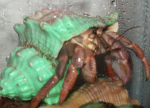Post by Angela on Jan 23, 2010 22:43:54 GMT -5
Hermit Crab Care Checklist:
-A tank that is at least ten gallons large.
Don’t forget that hermit crabs are wild animals and are used to having miles and miles of land to explore. Larger populations of hermit crabs will require larger tanks.
-Humidity Gauge
Hermit crabs have modified gills. If their air does not contain enough water, their gills will dry up, and they will die from stress.
-Temperature Gauge
Hermit crabs are cold-blooded and are also from hot regions.
-Extra shells for hermit crab to change into while the crab grows
Shells must be of appropriate size—not too large or too small.
Provide at least two or three unique shells for the hermit crab to switch in. Hermit crabs can be picky when it comes to picking out a new shell, but they are essential for the hermit crab’s health and well-being.
-Hermit crab-safe substrate, such as playsand or coconut fiber
NEVER use gravel; hermit crabs cannot dig under the gravel to molt like they have to.
The substrate has to be deep enough for your largest crab to completely bury itself during molting, so other crabs do not cannibalize it.
-Quality hermit crab food
Either buy hermit crab food or make it yourself. The majority of a hermit crabs’ diet consists of meat but also consists of fruits and vegetables. Hermit crabs must receive a variety of plant foods in order to thrive.
-Fresh, non-chlorinated water
Like fish, hermit crabs also have gills. Chlorine stings their gills, thus causing them deadly stress and irritation.
-Non-chlorinated salt water
Do NOT use table salt. Instead, use aquarium salt, such as Instant Ocean® or Oceanic® brands.
Generally, use 1 1/2 teaspoon per cup, though measurements may vary from brand to brand. Read instructions just in case.
C. Perlatus, or “strawberry” hermit crabs require a salt water bowl they can fully submerge themselves into.
-Climbing, Decorations, and Things to Hide Under
Offer your hermit crab toys, such as fake plants to climb on. Also, offer your hermit crabs things to climb under, such as half-logs, coconut huts, etc.
-Isolation Tank
An isolation tank is vital if you have more than one hermit crab. It will separate your hermit crab from others if it should become stressed or surface molt. Being with other hermit crabs while it is stressed out or molting will kill your hermit crab. It will only stress your crab out further, and molting hermit crabs will become cannibalized if left with a tank mate.
Isolation tanks should have the same conditions as your main tank, except it may be smaller due to your crab not wishing to move great distances while molting/under stress.
NEVER dig a hermit crab that is dug under up. It will only stress your hermit crab out greatly, thus causing potential death.
-A tank that is at least ten gallons large.
Don’t forget that hermit crabs are wild animals and are used to having miles and miles of land to explore. Larger populations of hermit crabs will require larger tanks.
-Humidity Gauge
Hermit crabs have modified gills. If their air does not contain enough water, their gills will dry up, and they will die from stress.
-Temperature Gauge
Hermit crabs are cold-blooded and are also from hot regions.
-Extra shells for hermit crab to change into while the crab grows
Shells must be of appropriate size—not too large or too small.
Provide at least two or three unique shells for the hermit crab to switch in. Hermit crabs can be picky when it comes to picking out a new shell, but they are essential for the hermit crab’s health and well-being.
-Hermit crab-safe substrate, such as playsand or coconut fiber
NEVER use gravel; hermit crabs cannot dig under the gravel to molt like they have to.
The substrate has to be deep enough for your largest crab to completely bury itself during molting, so other crabs do not cannibalize it.
-Quality hermit crab food
Either buy hermit crab food or make it yourself. The majority of a hermit crabs’ diet consists of meat but also consists of fruits and vegetables. Hermit crabs must receive a variety of plant foods in order to thrive.
-Fresh, non-chlorinated water
Like fish, hermit crabs also have gills. Chlorine stings their gills, thus causing them deadly stress and irritation.
-Non-chlorinated salt water
Do NOT use table salt. Instead, use aquarium salt, such as Instant Ocean® or Oceanic® brands.
Generally, use 1 1/2 teaspoon per cup, though measurements may vary from brand to brand. Read instructions just in case.
C. Perlatus, or “strawberry” hermit crabs require a salt water bowl they can fully submerge themselves into.
-Climbing, Decorations, and Things to Hide Under
Offer your hermit crab toys, such as fake plants to climb on. Also, offer your hermit crabs things to climb under, such as half-logs, coconut huts, etc.
-Isolation Tank
An isolation tank is vital if you have more than one hermit crab. It will separate your hermit crab from others if it should become stressed or surface molt. Being with other hermit crabs while it is stressed out or molting will kill your hermit crab. It will only stress your crab out further, and molting hermit crabs will become cannibalized if left with a tank mate.
Isolation tanks should have the same conditions as your main tank, except it may be smaller due to your crab not wishing to move great distances while molting/under stress.
NEVER dig a hermit crab that is dug under up. It will only stress your hermit crab out greatly, thus causing potential death.

